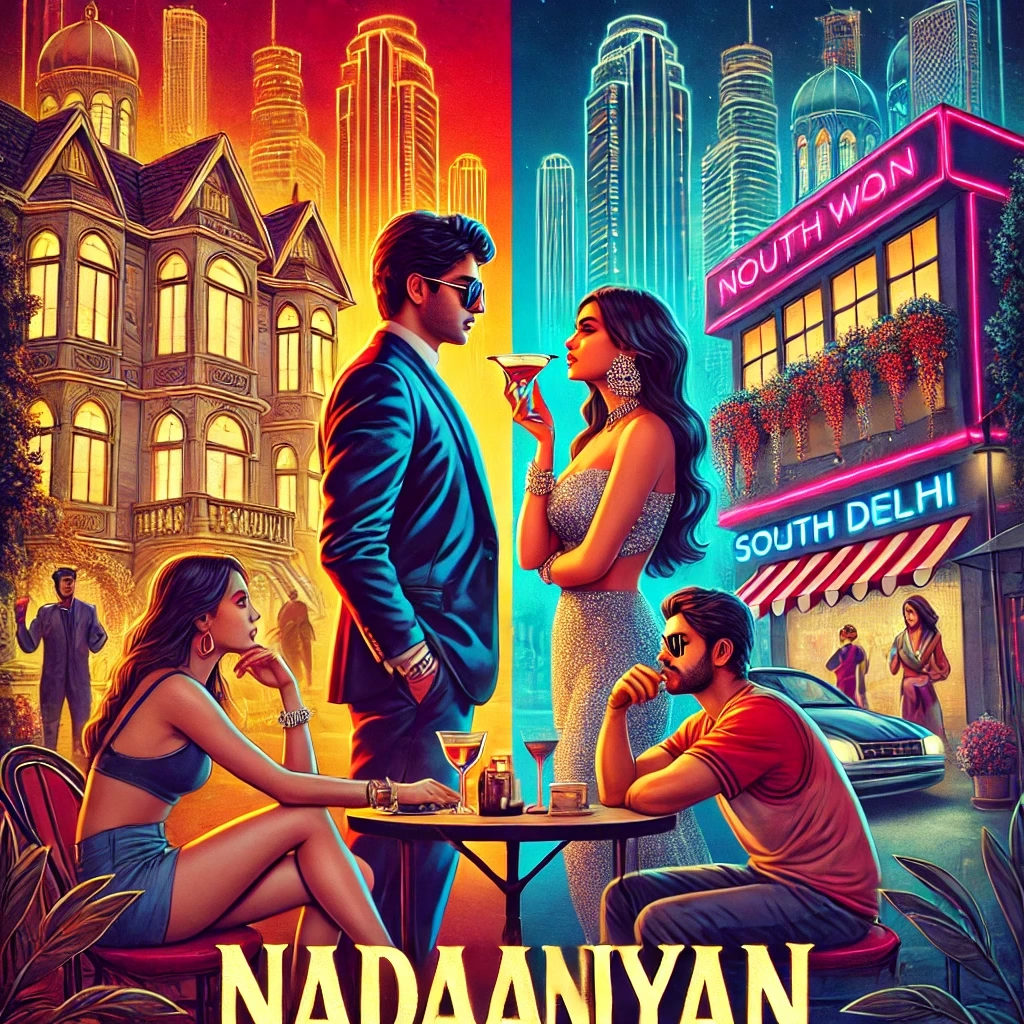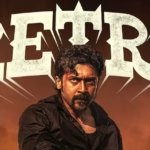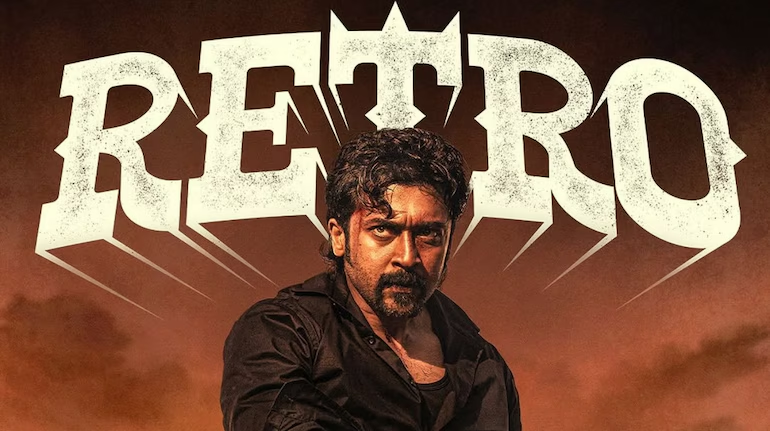Nadaaniyan, the much-anticipated Netflix romantic comedy featuring debut performance of Ibrahim Ali Khan alongside Khushi Kapoor, brings lavish visuals but struggles with substance. This comprehensive review explores whether the film lives up to its pre-release hype or falls victim to style over substance in Bollywood’s latest rom-com offering.
Released on Netflix on March 7, 2025, Nadaaniyan (which translates to “Foolishness”) marks director Shauna Gautam’s first feature film under Karan Johar’s Dharmatic Entertainment banner. The film attempts to blend youthful romance with social commentary, but largely fails to deliver anything beyond surface-level entertainment. While visually stunning with its high-production values and beautiful cast, the narrative suffers from predictable tropes and underdeveloped characters.
Plot: A Formulaic Tale of Fake Dating Gone Real
Nadaaniyan centers around Pia Jaisingh (Khushi Kapoor), a privileged South Delhi socialite who attends the elite Falcon High School. Despite her outward appearance of having everything, Pia struggles with personal issues, including strained relationships with her wealthy parents (played by Mahima Chaudhry and Suniel Shetty) and a tense situation with her best friends Rhea (Apoorva Makhija) and Sahira (Aaliyah Qureishi). When a misunderstanding threatens to ruin her friendship with Sahira, who suspects Pia of trying to steal her childhood crush Ayaan Nanda (Dev Agasteya), Pia concocts a desperate plan to save her “doston wali family” from disintegrating.
Enter Arjun Mehta (Ibrahim Ali Khan), a Noida-based scholarship student who is academically brilliant, athletically gifted, and focused solely on his career goals. He lives with his doctor father (Jugal Hansraj) and schoolteacher mother (Dia Mirza) but opts to stay in the school hostel for a semester. After witnessing Arjun’s six-pack abs during a debate team selection, Pia decides he’s the perfect candidate to be her fake boyfriend and offers him 25,000 rupees per week to play along.
What follows is a predictable journey where their pretend relationship gradually develops into something genuine. The class differences between them become apparent, with Arjun’s middle-class values clashing with Pia’s privileged upbringing. As they navigate the complexities of their arrangement, genuine feelings emerge, but misunderstandings threaten their budding romance.
Cast Performances: New Faces with Mixed Results
Ibrahim Ali Khan, son of Bollywood stars Saif Ali Khan and Amrita Singh, makes his acting debut in Nadaaniyan. His performance shows promise but lacks the depth needed to elevate the material. Khan demonstrates physical presence and charm but sometimes appears stiff in emotional scenes. His portrayal of Arjun Mehta suggests potential that remains largely unrealized due to the script’s limitations.
Khushi Kapoor, daughter of late actress Sridevi and producer Boney Kapoor, delivers a marginally improved performance compared to her debut in The Archies. As Pia Jaisingh, she attempts to convey a complex character hiding vulnerability beneath a privileged exterior. However, her performance often feels one-dimensional, with excessive head-shaking and facial expressions substituting for nuanced emotional portrayal. She does manage to shine in some confrontational scenes with her on-screen parents but struggles to capture the impulsiveness and mischief inherent to her character.
The supporting cast actually outshines the leads in many instances. Veterans like Mahima Chaudhry and Suniel Shetty bring gravitas to their roles as Pia’s estranged parents. Dia Mirza and Jugal Hansraj as Arjun’s loving middle-class parents provide warmth but remain underutilized. A nostalgic cameo by Archana Puran Singh, reprising her iconic Ms. Briganza character from Kuch Kuch Hota Hai, serves more as fan service than meaningful contribution to the narrative.
Direction and Production: Dharma’s Signature Style Without Substance
First-time director Shauna Gautam attempts to emulate the glossy, escapist entertainment that has become synonymous with Karan Johar productions. The film showcases lavish sets, beautiful costumes, and picture-perfect visuals that have long been hallmarks of Dharma Productions. Every frame is meticulously crafted to exude luxury and aesthetic appeal, particularly in the elite school setting where students dress like fashion models rather than actual teenagers.
However, Gautam’s direction falls short in extracting authentic performances from the cast or adding depth to the shallow script. The pacing feels uneven, with the film struggling to maintain interest during its nearly two-hour runtime. The director seems more concerned with visual aesthetics than emotional authenticity, resulting in a film that looks good but feels empty.
The screenplay by Riva Razdan Kapoor, Ishita Moitra, and Jehan Handa juggles multiple ideas without fully developing any of them. The writing veers between clumsy and lazy, relying heavily on contrived situations and convenient plot devices. The dialogue often feels artificial and fails to capture authentic youth culture, instead presenting a sanitized, Instagram-worthy version of teenage life that rings false.
Music and Soundtrack: A Bright Spot in an Otherwise Dim Film
One of Nadaaniyan’s few strengths is its musical score by Sachin-Jigar. The soundtrack features catchy compositions like “Ishq Mein” (performed by Sachet Tandon, Asees Kaur, and others) and “Galatfehmi” (sung by Tushar Joshi and Madhubanti Bagchi). These songs provide welcome relief from the film’s narrative shortcomings and are likely to enjoy popularity independent of the movie(Nadaaniyan Movie Review).
The background score complements the film’s mood effectively, though it occasionally veers into emotional manipulation during dramatic scenes. The musical sequences are filmed with vibrant choreography and colorful visuals, reminiscent of Karan Johar’s earlier works, though they sometimes feel disconnected from the story’s progression(Nadaaniyan Movie Review).
Themes: Superficial Exploration of Class Divide and Youth Culture

Nadaaniyan attempts to address several themes including class differences, family expectations, friendship dynamics, and self-discovery. However, its exploration of these topics remains surface-level and often contradictory. The film sets up a contrast between Pia’s troubled wealthy family and Arjun’s loving middle-class household but does little with this dynamic beyond reinforcing stereotypes.
The portrayal of elite school culture feels particularly tone-deaf, presenting students as one-dimensional caricatures obsessed with social media, designer clothes, and relationship drama. The film suggests that today’s teenagers are frivolous and shallow, which seems disconnected from the reality of modern youth who often demonstrate greater awareness of social issues and personal ambitions.
The class divide that serves as a central conflict is handled with minimal nuance. Arjun’s middle-class background is primarily used as a plot device rather than an opportunity for meaningful commentary. The film attempts to champion middle-class values while simultaneously glamorizing wealth and privilege, creating a confused message that undermines any potential social commentary.
| Theme | Description |
|---|---|
| Class Divide | Explores the gap between the elite and middle class. |
| Youth Culture | Showcases modern trends, parties, and social dynamics. |
| Fake Dating | A classic rom-com trope with unexpected consequences. |
| High School Romance | Love story set in elite private schools vs. regular ones. |
| Superficial Relationships | Glamorous yet shallow connections in high society. |
Visual Elements: Glossy Aesthetics Over Substance
Visually, Nadaaniyan delivers the high-production values expected from a Dharma production. The cinematography presents a polished, picture-perfect version of Delhi with emphasis on luxury settings and beautiful people. The color palette is vibrant and appealing, with soft lighting that creates a dreamlike quality appropriate for a romantic comedy.
The costume design emphasizes high fashion, with characters dressed in designer outfits that would be impractical for actual students. Pia’s wardrobe, in particular, seems curated for Instagram rather than school life. Arjun’s transition from simple clothing to more fashionable attire serves as a visual representation of his character’s journey, though this transformation feels superficial rather than meaningful.
The set design for Falcon High School creates an unrealistic fantasy version of educational institutions, resembling a luxury resort more than an actual school. Classrooms are rarely shown, with most scenes taking place in elaborately decorated common areas or at lavish parties. This approach reinforces the film’s disconnection from reality and its emphasis on style over substance.
Comparison to Other Films: Derivative and Unoriginal
Nadaaniyan borrows heavily from earlier Karan Johar productions, particularly Student of the Year and Kuch Kuch Hota Hai, without adding anything new to the formula. The elite school setting, attractive lead characters, and contrived romantic complications follow a template established decades ago. The film even includes direct references to Kuch Kuch Hota Hai through Archana Puran Singh’s cameo, highlighting its reliance on nostalgia rather than innovation.
Compared to contemporary coming-of-age romantic comedies, Nadaaniyan feels outdated in its approach and messaging. While films like Dil Dhadakne Do and Kapoor & Sons managed to blend entertainment with meaningful social commentary, Nadaaniyan fails to evolve beyond superficial entertainment. International teen films and series like To All the Boys I’ve Loved Before or Never Have I Ever handle similar fake-dating premises with greater depth and authentic character development.

Strengths and Weaknesses: Style Without Substance
Nadaaniyan’s primary strengths lie in its technical aspects – high production values, attractive visuals, and engaging music. The film is visually appealing and demonstrates Dharma Productions’ commitment to glossy presentation. Some performances from the supporting cast add credibility to otherwise thin characterizations.
However, the weaknesses significantly outweigh these positive elements. The screenplay lacks originality and emotional depth, relying on clichés rather than authentic storytelling. The lead performances, while earnest, fail to elevate the material. The film’s portrayal of youth culture feels disconnected from reality, presenting a sanitized, privileged version of teenage life that few viewers will relate to.
Most importantly, Nadaaniyan lacks heart beneath its glossy exterior. The emotional stakes never feel genuine, and the romantic connection between Pia and Arjun develops through plot convenience rather than meaningful character growth. The film’s attempts at addressing deeper themes like family dynamics and class differences remain superficial, undermining its potential impact.
Technical Aspects: Professional but Uninspired
Technically, Nadaaniyan meets the professional standards expected from a major production house. The editing maintains a steady pace, though some sequences feel unnecessarily prolonged. Sound design is competent, with clear dialogue and appropriate ambient effects. The cinematography captures the luxurious settings effectively, though it rarely attempts creative framing or memorable visual compositions.
The film’s technical proficiency highlights a missed opportunity – with such resources at their disposal, the filmmakers could have created something more innovative and impactful. Instead, Nadaaniyan plays it safe, following established formulas without technical experimentation or creative risk-taking.
Director’s Vision: Promising but Unfulfilled
As a debut director, Shauna Gautam shows potential in handling large-scale production elements and creating visually appealing sequences. Her background (which isn’t extensively detailed in the available sources) seems to have prepared her for the technical aspects of filmmaking. However, her direction lacks the distinct personal voice that would elevate the material beyond its formulaic structure.
Gautam appears heavily influenced by Karan Johar’s directorial style, focusing on glossy aesthetics and melodramatic emotional beats. This approach worked for Johar’s films in earlier decades but feels outdated in contemporary cinema without substantial modernization. Gautam fails to bring a fresh perspective to familiar material, resulting in a film that feels derivative rather than inspired.
Target Audience: Limited Appeal Beyond Fans of the Stars
Nadaaniyan seems primarily targeted at younger viewers who follow the social media presence of its star cast. Fans of Ibrahim Ali Khan and Khushi Kapoor might appreciate seeing these star kids in leading roles, regardless of the film’s quality. The movie also attempts to appeal to nostalgic fans of Karan Johar’s earlier works, with direct references and similar aesthetic sensibilities.
However, viewers seeking meaningful storytelling or authentic representation of youth culture will likely be disappointed. The film’s shallow approach to relationships and privileged perspective limits its appeal to those who can overlook these issues for the sake of visual pleasure and light entertainment.
Cultural Impact: Reinforcing Star Kid Culture
Nadaaniyan represents the continued prominence of nepotism in Bollywood, launching the careers of two star kids with significant industry connections. Ibrahim Ali Khan, son of Saif Ali Khan, and Khushi Kapoor, daughter of late superstar Sridevi, join the growing list of second-generation actors benefiting from family connections in the industry.
The film’s reception reflects growing audience fatigue with this phenomenon. Critical responses frequently mention the “nepo-kid” aspect, suggesting that viewers are increasingly aware of and critical toward the industry’s reliance on established film families. This context influences perceptions of the film beyond its standalone quality, placing it within broader conversations about merit and opportunity in Bollywood.
Final Verdict: A Disappointing Misfire
Nadaaniyan ultimately fails to deliver on its promise, offering glossy visuals and attractive stars but little substance beneath its polished surface. The film represents a missed opportunity to update the romantic comedy formula for contemporary audiences while maintaining the entertainment value that made earlier Dharma productions successful.
With its weak screenplay, underdeveloped characters, and superficial treatment of potentially meaningful themes, Nadaaniyan earns approximately 2 out of 5 stars. It may provide momentary diversion for viewers seeking undemanding entertainment but lacks the emotional resonance or cultural relevance to leave a lasting impression.
The film serves as both a launchpad for its leading stars and a cautionary tale about prioritizing style over substance. Whether Ibrahim Ali Khan and Khushi Kapoor can transcend this disappointing debut to establish meaningful acting careers remains to be seen, but Nadaaniyan does little to showcase their full potential.
Behind-the-Scenes: Production Context and Development
The development of Nadaaniyan appears to have been driven by the dual objectives of launching Ibrahim Ali Khan’s acting career while capitalizing on the Netflix streaming platform’s global reach. Karan Johar’s Dharmatic Entertainment, the digital content arm of Dharma Productions, has been actively producing content for streaming platforms, with mixed results in terms of quality and reception.
The film was reportedly conceived as a youthful romantic comedy that would appeal to Netflix’s core demographic while showcasing its attractive lead stars. The choice of a first-time director in Shauna Gautam suggests an attempt to bring fresh perspective to familiar material, though the execution ultimately adheres closely to established Dharma formulas.
Filming reportedly took place in Delhi’s upscale neighborhoods to capture the elite milieu in which the story is set. The production design team created elaborate sets for Falcon High School, emphasizing luxury and visual appeal over educational realism. This approach aligns with the film’s overall prioritization of aesthetics over authenticity.
The special screening of Nadaaniyan coincided with Ibrahim Ali Khan’s 24th birthday on March 5, 2025, further emphasizing the film’s function as a star vehicle rather than a standalone creative endeavor. Industry insiders and family members reportedly attended this event, highlighting the interconnected nature of Bollywood’s star system.
Audience Expectations vs. Reality: Marketing Versus Content
The marketing campaign for Nadaaniyan emphasized its glossy visuals, attractive lead pair, and connection to Karan Johar’s successful romantic comedies. Trailers highlighted the film’s fake-dating premise, luxurious settings, and musical sequences, creating expectations for light, enjoyable entertainment in the Dharma tradition.
This marketing approach set audience expectations that the film ultimately fails to meet. While Nadaaniyan delivers on its promise of visual appeal and attractive stars, it lacks the emotional depth and memorable characters that made earlier Dharma romances successful. The disconnect between marketing and actual content likely contributes to the film’s negative reception.
The promotional materials also heavily emphasized the debuts of Ibrahim Ali Khan and Khushi Kapoor, capitalizing on public interest in these star kids. This focus on lineage rather than storytelling or creative vision reinforces criticism about the film’s priorities and industry nepotism more broadly.
Links
- News18: Nadaaniyan Review: Khushi Kapoor And Ibrahim Ali Khan Give Their Best In This Enjoyable Film
- NDTV: Nadaaniyan Review: A Passably Lively But Spectacularly Shallow Rom-Com
- Indian Express: Nadaaniyan Movie Review: Ibrahim Ali Khan, Khushi Kapoor Film Rehashes Every Karan Johar Romcom Without His Sparkle











